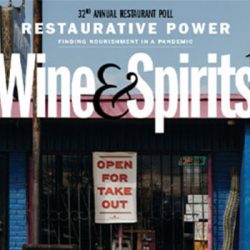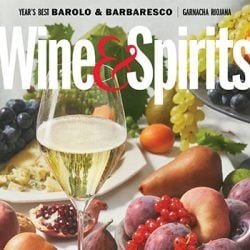The pandemic has led to many new jobs but one of them is unexpected: chief bottle washer.
In this case, the meaning is literal. Tapping into current industry trends on sustainability, and adapting to the curveballs of the pandemic, two New York–based companies have recently pivoted to develop wine in reusable bottles. The plans are currently embryonic but initial results indicate a promising trend.
The startup Good Goods developed reusable packaging for food. Consumers could grab fresh foods in reusable glass jars from a kiosk and return the jar to a vending machine for future use. The only trouble is that their machines were in high-foot-traffic areas, such as office buildings, subways and universities, which saw significant reductions in foot traffic after lockdowns. So, in a pivot the company pitched a reusable wine bottle to their investors.
Good Goods rolled out a trial at ten wine stores in the New York City area with more than 4,000 customers during the pandemic. About 20 wines were involved, spanning prices from $15 to $40. The results were astonishing: 88 percent of customers returned the bottles, and the wines involved in the trial saw sales increase an eye-popping 70 percent.
“Reuse has been around for a while; just think of the milkman,” says Andy Rose, Head of Business Development at Good Goods. “But there hasn’t been innovation around the customer experience.” Good Goods has QR codes on bottles and customers who make returns receive text messages about their returns and credits in their account.




Most recently, Good Goods has partnered with Wild Arc Farm in New York’s Hudson Valley and Jenny & François Selections in NYC on their first co-branded wine using their QR code return system. (Regarding Wild Arc Piquette, see “Waste Not: Upcycling Grape Pomace,” by Sydney Love, W&S June 2020) The company is in talks with other US producers and hopes to launch additional wines in reusable bottles this year.
Gotham Project also saw their business radically affected by the pandemic closures of restaurants. Started in 2009 by Charles Bieler and Bruce Schneider with one Finger Lakes riesling, their “wine on tap” business has grown to offer over three-dozen reusable-keg wines from Spain, Italy and beyond. The wines, imported in bulk, are kegged at their facility in Bayonne, New Jersey. When a restaurant kicks the keg, they send it back for refilling.
But with restaurants closed, this virtuous circle stopped its rotation. So Bieler and Schneider extended the concept to test bottled wine for sale at shops, and ultimately, restaurants in three markets, including New York. They developed a Burgundy-style bottle, embossed with “Return & Reuse” that consumers can enjoy at home and then bring back to the store. The bottles are then returned to Gotham for refilling.
“We think of these bottles as mini-kegs. This format allows us to reach an even wider audience because anyone can participate,” says Schneider.


“We think of these bottles as mini-kegs. This format allows us to reach an even wider audience because anyone can participate.”
Bruce Schneider, Gotham Project
Energy Savings
The state government of Styria in Austria developed a plan for wine bottle reuse in 2011. They currently have 80 participating wineries, 100 supermarket branches, and 5 million bottles in circulation with the embossed emblem of the Styrian panther.
Although glass can be infinitely recycled, producing it is energy intensive. Sterilizing and reusing an existing bottle reduces energy usage by 96 percent, according to sources involved with the Styrian project.
Distell, the large wine maker and distiller from South Africa, initiated a bottle-return policy about a decade ago called “Give Back, Get Back.” In 2018, the company washed 168.5 million bottles for reuse at their four facilities, accounting for 28 percent of their glass needs. They calculate that this 101 tons of reused bottles saved 191 tons of carbon dioxide emissions if the same wines had been packaged in new glass.
Incentives
“[Consumers] should return the bottles because it is the right thing to do for the planet,” says André Hueston Mack, owner of VyneYard, a wine shop in the Prospect-Lefferts Garden area in Brooklyn. Mack stocks some Gotham Project “Return & Reuse” bottles and says there has been strong interest in the concept but that returns are “approaching twenty-five percent.” He hopes to get to 50 percent by the end of the year, in part because Gotham Project will soon offer a donation to the National Parks Foundation for each return.
At Good Goods, their food container returns showed the importance of understanding consumer psychology. Instead of pricing fresh food in a reusable glass container at $8 for food with a $1 container deposit, they simply priced it at $9 and offered $1 to a consumer’s Good Goods account for each return. “This tweak makes a huge difference,” says Paul Christophe, the company’s Chief Technology Officer.
Over in Styria, the bottles in the program do not require a deposit but consumers can receive a ten-cent credit from some wineries. The project’s goal is a 50 percent return rate.
Consumer interest in sustainable packaging has been growing since at least the mid-2000s, when pricey wines came in sometimes obscenely heavy bottles. The 2008 recession led to a light-weighting of bottles as the industry looked to cut costs as well as tie into green consumer trends. Although it is still the early innings, perhaps pandemic-driven pivots will be the cause of another packaging shift—using bottles more than once.
Tyler Colman, PhD, is a longtime contributor to Wine & Spirits and the author of Wine Politics: How Governments, Enviornmentalists, Mobsters and Critics Affect the Wines We Drink. He blogs at DrVino.com.
This story appears in the print issue of August 2021.
Like what you read? Subscribe today.


















